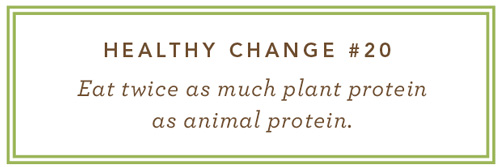Protein 101

The quick story: When Americans think protein, meat comes to mind—about 80% of our protein is animal sourced. The better answer: Get 2/3 of your protein from plants and 1/3 from animal sources.
____________________________________________________________________________________________
Don’t you love the boy in the picture (with a piece of saved string around his neck)? It’s a little faded because I took it many years ago after a volcano climb in El Salvador. There’s a point to the picture—the extended stomach occurs with children who don’t get all the essential amino acids after weaning. Which brings us to protein.
Protein deficiency is uncommon in the U.S. We need at least 8-10% of our calories as protein—we get 15-16%. So we get plenty of protein; the issue is our protein source. Around the world, plants—especially rice, corn and wheat—are the main source of protein. Americans eat meat.
Primer: Proteins are the most abundant molecules in our body, after water. They are the building blocks for cells but they also provide thousands of other functions. Enzymes, for example, are made from protein. There are many different proteins, literally hundreds of thousands in our proteome, but they are assembled from just 20 amino acid building blocks. Eight amino acids are considered essential (though this varies among people) so foods with all eight are termed complete.
Protein from animals is usually complete. Plants are simpler life forms so the protein is less complete. To make plant protein complete we combine complementary groups such as grains with legumes or nuts and seeds. The day I took the picture above, we had climbed a high volcano and were famished on our way back. Coming across a grass hut far from any road, we asked a native woman for food. The lady was kind; she wrapped black beans from a clay pot in her thick corn tortillas to make a life-saving lunch we could eat without utensils. The conditions were primitive but the protein was complete and I can still remember how good it tasted. (And the lady seemed pleased with our payment.)
Some combinations that make plant proteins complete:
o Peanut butter on whole-wheat bread.
o Rice and beans.
o Trail mix (peanuts and sunflower seeds).
Animal vs. Plant Protein
You can’t eat too much protein if your diet is built on plant foods; many fruits and vegetables contain less than 3%. Rice has 3-4% protein, legumes and lentils are 4-10%, wheat has 10-13%, and nuts vary from 10 to 20%. Studies reveal that humans are more tolerant of plant protein than the protein from animals.
Animals and fish have higher levels of protein, ranging from 15-40%. To repeat, when we think of protein food in the U.S., we think of meat. Of the 15% of our diet that is protein, about 80% comes from meat. In China less protein is consumed and just 10% is meat. A good compromise lies somewhere between the Chinese and American diet.
This leads us to an excellent book by T. Colin Campbell, PhD, descriptively titled The China Study: The Most Comprehensive Study of Nutrition Ever Conducted and the Startling Implications for Diet, Weight Loss and Long-term Health. We’ll take a closer look at Campbell’s work in the next post but the bottom line is we should get more of our protein from plant sources (about 2/3) and less from animals (about 1/3, or 5% of calories). Campbell’s research establishes a strong link between high levels of animal protein and cancer as well as heart disease, obesity and diabetes, and autoimmune diseases. Studies confirm Campbell’s work, as does food tradition and scripture.
If you have a Bible in your home, turn to the first page and read the Creation account given in the first chapter of Genesis. Genesis not only tells of the creation of modern humans, it also tells of the creation of our food supply. After we are given dominion over animals, we are directed (v. 29) to build our dietary on every herb (meaning vegetables, grains and legumes) and the fruits of trees. The dietary laws given to Moses restrict how meat is to be eaten. The LDS scripture called the Word of Wisdom counsels that meat should be eaten “sparingly”. People vary in their needs and “sparingly” allows for a range of interpretation, but I have taken it to mean something like 10% of all calories. Returning to The China Study, this provides about 1/3 of protein from meat.
Budget Wisdom: It’s NOT more expensive to eat healthy once you commit to planning and cooking. (In fact it’s a bargain if you consider the medical expenses avoided.) Protein provides a good example. Meat averages around $8/lb in the store but most plant proteins can be purchased for around a dollar per pound. If you replace your basic feedlot steak with a smaller amount of pasture-fed beef in a soup or stew, or with shrimp on a salad, you will have a healthier diet at a lower cost.
An important point: If you want to reduce your intake of pollutants, there is greater benefit from eating less meat and dairy than paying the higher cost of organic produce. Excessive meat is bad for your body as well as your budget. Incidentally, liver (pasture-fed, please) though out of favor, is the best meat bargain.

How-To-Do-It:
1. Here’s the math for an average person (2500 calorie/day diet) who wishes to limit animal protein to 1/3 of total protein. The weekly shopping list can include:
a. 1 lb. of meat or fish,
b. 4 eggs,
c. 7 cups of milk,
d. 4 servings (1 oz. each) of cheese.
2. A simpler plan: Because meat is the main source of animal protein, limit your average intake to ½ serving per day and eat normal amounts of eggs and dairy.
3. Use meat more to flavor foods, and less as an entrée. (Recipe for Skip’s Scalloped Potatoes to follow.)
4. Include a pot of legumes in each week’s menu.
5. For snacks, include a daily serving of nuts.
Please share your ideas on how to get more of our protein intake from plants.
Need a reminder? Download our Healthy Change reminder card. Print and fold, then place in your kitchen or on your bathroom mirror to help you remember the Healthy Change of the week.
 Sunday, May 15, 2011 at 3:43PM | by
Sunday, May 15, 2011 at 3:43PM | by  Skip Hellewell |
Skip Hellewell |  21 Comments | | in
21 Comments | | in  healthy change,
healthy change,  meat |
meat |  Email Article
Email Article 
Reader Comments (21)
The movie knives over forks is a documentary that talks about the china study. It convinced my husband in one sitting. Also, sad but true, it seems that people are more willing to eat less/no meat if they are experiencing health problems.
Love this blog. I have been following for a year now, and am just finally getting it. Thanks Skip!